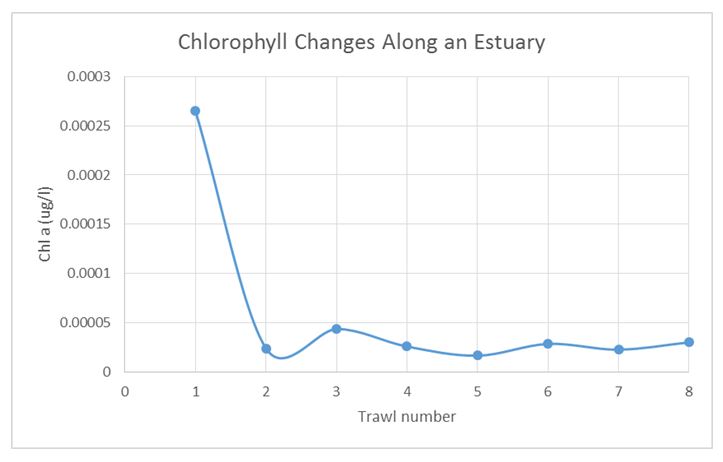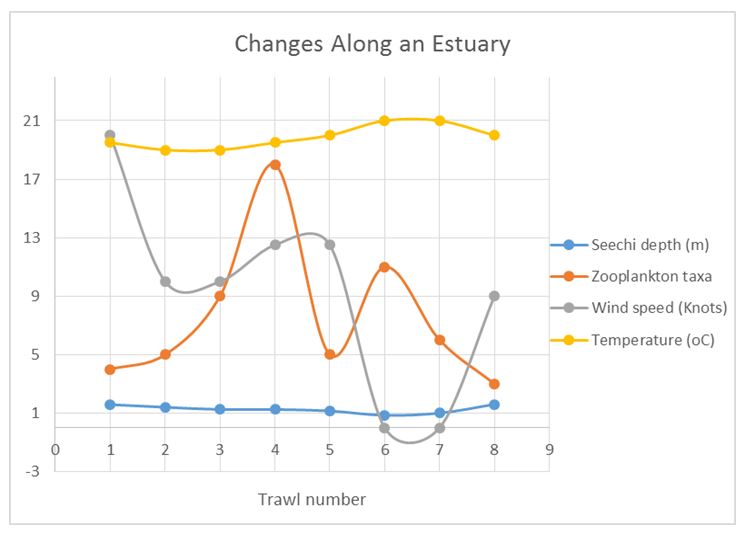Introduction
The estuarine environment exemplifies a transition between freshwater and marine environment (Zhang 2011). Therefore, the characteristics of an estuarine habitat are largely influenced by these two ecosystems. River movements and tidal waves propel the riverine and maritime populations to estuaries and hence influence the diversity and profusion of estuarine communities (Rochelle-Newall 2011). Consequently, factors such as salinity, turbidity, and nutrient concentrations are altered. Chlorophyll is a vital pigment that takes in light energy that is used in the production of plant food through photosynthesis (Blankenship 2013). This important molecule is found in phytoplankton, particularly algae and cyanobacteria. The amount of chlorophyll determines the rate of photosynthesis and the populations of phytoplankton, which also affects the diversity of zooplankton that feed on phytoplankton (Gołdyn and Kowalczewska-Madura 2008).
The objective of this lab was to extract and measure the quantity of chlorophyll-a present in phytoplankton and use it to estimate the biomass of phytoplankton. It was hypothesized that the abundance of phytoplankton and abundance and diversity of zooplankton varied along an estuarine gradient.
Methods
A 15 ml centrifuge tube containing a sample of phytoplankton on a filter paper was collected, and the date and collection site of the sample were recorded. 8 ml of analytical grade ethanol was then added to the tube in a fume chamber after which the tube was wrapped in aluminum foil to prevent the disintegration of chlorophyll by light. The tube was labeled appropriately, shaken vigorously, and placed in a test tube holder in the refrigerator for two hours to permit the extraction of chlorophyll into the ethanol. The sample was shaken intermittently in the course of the two-hour extraction period. The sample was centrifuged for 5 minutes to detach the filter paper from the chlorophyll extract. The chlorophyll extract was transferred into a 1-cm path length cuvette using a disposable pipette. Stock ethanol in a second cuvette was used as a blank to calibrate the spectrophotometer at a wavelength of 630 nm. The absorbance of the chlorophyll extract was then measured. A similar procedure was repeated to obtain the absorbance of the sample at wavelengths of 649, 665, and 750 nm.
The concentrations of chlorophyll a were computed using the formula
Where v = the used volume of ethanol in mL (8 mL)
V = the volume of filtered sample in liters
E = absorbance at different wavelengths obtained above (Ritchie 2008).
It was assumed that the amount of chlorophyll was the same in each phytoplankton cell. The amount of chlorophyll in the extracts was then used as a measure of the phytoplankton biomass.
Results
The amount of chlorophyll decreased as the trawls moved further into the estuary. The highest chlorophyll concentration was recorded in trawl 1, which was the first sampling point (Figure 1). Chlorophyll concentrations increased with a decrease in the turbidity of the water. The highest number of zooplankton taxa were recorded at point 4 while the lowest was at point 8. The speed of wind and temperature also varied along the estuary. The findings of the lab are summarized below in Figure 2.


Discussion
Factors such as wind and temperature influenced the distribution of phytoplankton hence chlorophyll levels along the estuary. According to Baldwin (n.d.), low temperatures and elevated wind speeds caused the instability of the water column, which transferred nutrient-rich water to phytoplankton. Such changes also influenced the turbidity of the water. The abundance of phytoplankton and the abundance and diversity of zooplankton varied along the estuarine gradient with an increase in the number of species in the midsections of the estuary. Zooplankton fed on phytoplankton, and it was expected that more taxa would be found close in areas with high chlorophyll levels. However, other features such as temperature and salinity as reported by Hwang et al. (2010) could have influenced the abundance and diversity of zooplankton. These observations were in agreement with those reported by Rochelle-Newall, which followed the concept that an estuarine environment had varying chemical properties due to the transition from fresh to saltwater (2011).
The amount of chlorophyll in plankton increased as the turbidity decreased. This observation could be attributed to the amount of light that penetrated the water. Phytoplankton biomass was expected to be proportional to water turbidity (Rawat, Dookia, and Sivaperuman 2015). However, the opposite was observed in the experiment suggesting that sediment and other particles impeded the penetration of light hence lowering the amount of photosynthesis that took place (Zhang 2011). Other factors that influenced turbidity included viewer predispositions, murkiness, and turbulence of the water as well as the position of the sun (Rawat, Dookia, and Sivaperuman 2015).
Therefore, this lab concluded that estuaries had varying physical and chemical properties that influenced the abundance and diversity of phytoplankton in the water.
References
Baldwin, S n.d, A preliminary investigation on turbidity and chlorophyll-a patchiness in Lake Tanganyika, Kigoma Bay, 2015. Web.
Blankenship, R E 2013, Molecular mechanisms of photosynthesis, John Wiley & Sons, Hoboken.
Gołdyn, R & Kowalczewska-Madura K 2008, “Interactions between phytoplankton and zooplankton in the hypertrophic Swarzędzkie Lake in Western Poland,” Journal of Plankton Research vol. 30 no.1, pp. 33-42.
Hwang, J-S, Kumar, R, Hsieh, C-W, Kuo, A Y, Souissi, S, Hsu, M-H, Wu, J-T, Liu, W-C, Wang, C-F, & Chen, Q-C 2010, “Patterns of zooplankton distribution along the marine, estuarine, and riverine portions of the Danshuei ecosystem in Northern Taiwan,” Zoological Studies vol.49 no.3, pp. 335-352.
Rawat, M, Dookia, S, & Sivaperuman, C 2015, Aquatic ecosystem: biodiversity, ecology and conservation, Springer, New Delhi.
Ritchie, R J 2008, “Universal chlorophyll equations for estimating chlorophylls a, b, c, and d and total chlorophylls in natural assemblages of photosynthetic organisms using acetone, methanol, or ethanol solvents,” Photosynthetica vol.46 no.2008, pp. 115-126.
Rochelle-Newall, E J, Chu V T, Pringault O, Amouroux D, Arfi R, Bettarel Y, Bouvier T, Bouvier C, Got P, Nguyen T M H, Mari X, Navarro P, Duong T N, Cao T T T, Pham T T, Ouillon S, & Torreton J-P 2011, “Phytoplankton diversity and productivity in a highly turbid, tropical coastal system (Bach Dang Estuary, Vietnam),” Biogeosciences Discussions vol.8 no. 2011, pp. 487–525.
Zhang, Y, Lin, H, Chen, C, Chen, L, Zhang B, & Gitelson, 2011, “Estimation of chlorophyll-a concentration in estuarine waters: a case study of the Pearl River Estuary, South China Sea,” Environmental Research Letters, vol. 6 no. 024016, pp. 1-9.